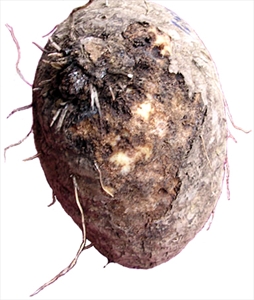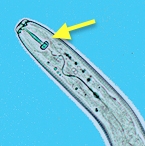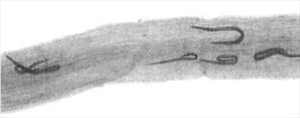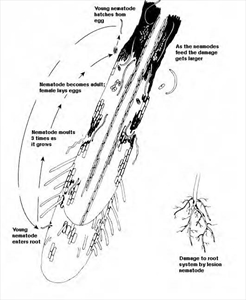Dry rot of yam, brown dry rot, banana root nematode, toppling of banana
Pacific Pests, Pathogens and Weeds - Online edition
Pacific Pests, Pathogens & Weeds
Yam lesion nematode (008)
Pratylenchus coffeae
Asia, Africa, North, South and Central America, Europe, Oceania. It is recorded from Australia, Cook Islands, Fiji, Kiribati, Niue, Palau, Papua New Guinea, Samoa, Solomon Islands, Tonga, and Vanuatu. The nematode is a major problem on yam (field and storage) in parts of Papua New Guinea, Solomon Islands, and Vanuatu.
In Pacific island countries, lesion nematodes cause major diseases on yam (Dioscorea alata) and banana (Musa species), and surveys have found them associated with many other crops, although specific diseases have not been identified. Many weeds are also hosts. Note; the burrowing nematode, Radopholus similis, causes a similar disease on banana (see Fact Sheet no. 257).
Roots are infected and killed, and entry into the developing tubers causes a shallow brown, dry rot, that continues in storage (Photos 1&2).
Pratylenchus has six life stages: egg, juvenile (4) and adult (Diagram). The nematodes lay eggs in the root, or in soil close by. Eggs hatch in a few days and the young nematodes, called juveniles or larvae, moult several times before they become adult. The larvae and adults enter the roots and then force their way between or through the cells using their hollow stylets or spears (Photo 3) to suck out the cell contents.
The life cycle is 2-3 weeks, depending on moisture and temperature. When the cells die, the nematodes migrate through the root (Photo 4) or tuber in search of healthier parts, or they return to the soil and search for another root. The nematodes spread short distances in soil water. They are spread long distances on yam setts and banana suckers.
Young and adult nematodes feed on roots of weeds and on the roots of other crops between crops of yam and banana. They also remain alive in stored yam tubers. When infected yam tuber pieces or banana suckers are planted, the nematodes emerge and move through the soil until they find young roots to infect.
On yam: damage to roots prevents the plant from taking up water and nutrients. When roots are damaged, plants become stunted and/or die early. Often, symptoms of the disease are not seen until the yams are harvested because: (i) in many yam gardens the foliage of different plants is mixed together, making it difficult to see individual plants; and (ii) damage done by nematodes often comes late, so symptoms of poor growth can be mistaken for early maturity.
Damage to the tubers does not stop at harvest. The nematodes continue to multiply during storage, and the brown, shallow, dry rots spread further (Photos 1&2). Often, other organisms help with the decay. Decay of the outer areas of the tubers means that shoots do not develop and, consequently, there is a loss of planting material.
On banana: Spots appear due to the nematodes feeding and breeding inside the roots; later the spots join together forming characteristic red and/or black patches - best seen when roots are split (Photo 5). The roots die and the outer parts rot. The result is a weak, stunted root system; plant growth is slow, fruiting is poor and plants readily fall over in the wind (Photo 6).
Look for signs of dry rot on yam tubers at harvest, and in storage. Look for bananas that have blown over, and inspect the roots for red and/or black patches.
CULTURAL CONTROL
Before planting:
- Use local knowledge, and plant where crops have grown well before.
- Inspect every yam tuber piece used for planting and discard any with dry rot. Wipe knife with bleach between cutting each tuber.
- Remove soil from bananas suckers, cut off roots and cut out rots from the corms. As for yam, use bleach to clean the knife used to trim the suckers, especially if the knife has been used to cut out rots. Cleaning of suckers in this way is often combined with hot water treatment (see below).
After harvest:
- Leave at least 3 years between crops of yam grown on the same land. If possible, allow the land to fallow naturally or plant marigolds or cover crops, e.g., green panic (Panicum maximum), siratro (Macroptilium atropurpureum) or velvet bean, Mucuna sp.
- Do not store tubers with signs of dry rot. Regularly inspect tubers in storage; remove those with dry rot. The healthy flesh can be eaten.
RESISTANT VARIETIES
There is no information on resistance among Dioscorea alata yam varieties. However, trials have found that the banana variety FHIA-01 has tolerance to Radophilus similis, so it would be worth testing it against Pratylenchus coffeae. Tolerance to Pratylenchus is also reported for Yamgambi km5. Both these varieties are in the collection of varieties held by the CePaCT lab Secretariat for the Pacific Community.
HOT WATER TREATMENT
- Hot water treatment of yam tubers and banana suckers is an effective method of killing nematodes, but has to be done carefully. Dip yams in water at 51°C for 10 minutes, and peeled banana suckers in water at 50°C for 20-25 minutes. Use a thermometer: do not guess!
- IITA, the International Institute of Tropical Agriculture, advises dipping peeled suckers of banana and plantain in boiling water for between 20 and 30 seconds. This method has the advantage that a thermometer is not required, only a watch with a second hand. (If no watch, take 30 pebbles, place them on the floor and pick them up one at a time and put into a small container). Note, this test applies to banana and plantain only.
CHEMICAL CONTROL
Chemical control is not a method that can be used for the management of these diseases.
AUTHORS Helen Tsatsia & Grahame Jackson
Information (and Diagram) from Davis EL, MacGuidwin AE (2005) Lesion nematode disease. The Plant Health Instructor. DOI: 10.1094/PHI-I-2000-1030-02; and from Hauser S, Coyne D (2010) A hot bath cleans all: Boiling water treatment of banana and plantain. Technical Innovation Brief. No. 8. (https://www.ctc-n.org/sites/www.ctc-n.org/files/resources/4ea6bfcd-2658-4dac-bf31-03861661b3dc.pdf). Photo 1 V Vanstone Pratylenchus penetrans: a horticulturally significant root lesion nematode. Department of Agriculture and Food, Government of Western Australia. Photo 4 John Bridge, CABI, UK.
Produced with support from the Australian Centre for International Agricultural Research under project PC/2010/090: Strengthening integrated crop management research in the Pacific Islands in support of sustainable intensification of high-value crop production, implemented by the University of Queensland and the Secretariat of the Pacific Community.










